Guide To Water Leakage Discovery In The House
Guide To Water Leakage Discovery In The House
Blog Article
Nearly everybody may have his or her own conception when it comes to Leaking water lines.

Early discovery of dripping water lines can minimize a prospective calamity. Some tiny water leakages might not be visible.
1. Check Out the Water Meter
Every home has a water meter. Checking it is a surefire way that assists you uncover leaks. For starters, turn off all the water sources. Guarantee no person will certainly purge, use the tap, shower, run the cleaning maker or dishwashing machine. From there, most likely to the meter and watch if it will transform. Since no person is using it, there must be no activities. That shows a fast-moving leakage if it moves. If you spot no changes, wait an hour or two and inspect back once more. This indicates you may have a slow-moving leakage that might even be below ground.
2. Examine Water Intake
Assess your water expenses and track your water intake. As the one paying it, you need to observe if there are any type of discrepancies. If you detect sudden changes, in spite of your intake coinciding, it indicates that you have leaks in your plumbing system. Keep in mind, your water expense ought to fall under the exact same range monthly. An unexpected spike in your costs suggests a fast-moving leakage.
At the same time, a steady increase every month, despite the very same practices, shows you have a slow leak that's also gradually intensifying. Call a plumber to extensively check your building, especially if you feel a warm location on your flooring with piping underneath.
3. Do a Food Coloring Examination
30% comes from bathrooms when it comes to water intake. Examination to see if they are running effectively. Drop specks of food color in the tank and wait 10 mins. If the shade somehow infiltrates your dish throughout that time without flushing, there's a leakage in between the storage tank as well as dish.
4. Asses Exterior Lines
Do not fail to remember to inspect your exterior water lines as well. Examination spigots by connecting a yard pipe. Must water leak out of the link, you have a loose rubber gasket. Change this and ensure all connections are tight. It will aid obtain it professionally took a look at as well as kept every year if you've got a lawn sprinkler system. One little leak can squander lots of water and also increase your water expense.
5. Inspect and also Examine the Circumstance
Home owners need to make it a routine to inspect under the sink counters as well as also inside cupboards for any kind of bad odor or mold and mildew growth. These two warnings show a leak so punctual attention is called for. Doing routine assessments, also bi-annually, can save you from a major problem.
If you recognize your residence is currently old, keep a watchful eye on your heating units, hose pipes, pipes and so on. Look for stainings and deteriorating as the majority of pipes and home appliances have a life expectancy. They will certainly also naturally weaken as a result of tear and also put on. If you believe dripping water lines in your plumbing system, don't await it to intensify. Call a professional plumber right now so you don't end up with a terrible mess in your house.
Early detection of dripping water lines can minimize a potential catastrophe. Some small water leakages may not be noticeable. Examining it is a surefire means that helps you find leaks. One tiny leak can squander tons of water and surge your water bill.
If you believe dripping water lines in your plumbing system, don't wait for it to rise.
WARNING SIGNS OF WATER LEAKAGE BEHIND THE WALL
PERSISTENT MUSTY ODORS
As water slowly drips from a leaky pipe inside the wall, flooring and sheetrock stay damp and develop an odor similar to wet cardboard. It generates a musty smell that can help you find hidden leaks.
MOLD IN UNUSUAL AREAS
Mold usually grows in wet areas like kitchens, baths and laundry rooms. If you spot the stuff on walls or baseboards in other rooms of the house, it’s a good indicator of undetected water leaks.
STAINS THAT GROW
When mold thrives around a leaky pipe, it sometimes takes hold on the inside surface of the affected wall. A growing stain on otherwise clean sheetrock is often your sign of a hidden plumbing problem.
PEELING OR BUBBLING WALLPAPER / PAINT
This clue is easy to miss in rooms that don’t get much use. When you see wallpaper separating along seams or paint bubbling or flaking off the wall, blame sheetrock that stays wet because of an undetected leak.
BUCKLED CEILINGS AND STAINED FLOORS
If ceilings or floors in bathrooms, kitchens or laundry areas develop structural problems, don’t rule out constant damp inside the walls. Wet sheetrock can affect adjacent framing, flooring and ceilings.
https://www.servicemasterbyzaba.com/blog/how-to-detect-water-leakage-in-walls/

Do you appreciate reading up on Hacks to detect leaks? Leave a comment down below. We'd be delighted to listen to your thinking about this write-up. In hopes that you come back again in the future. Remember to set aside a second to promote this blog post if you enjoyed it. Thanks so much for going through it.
Report this page